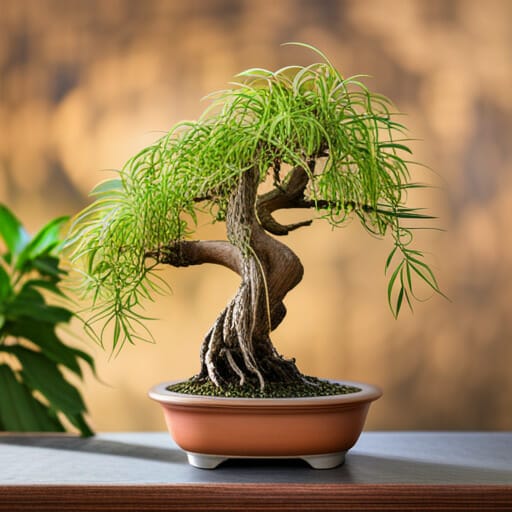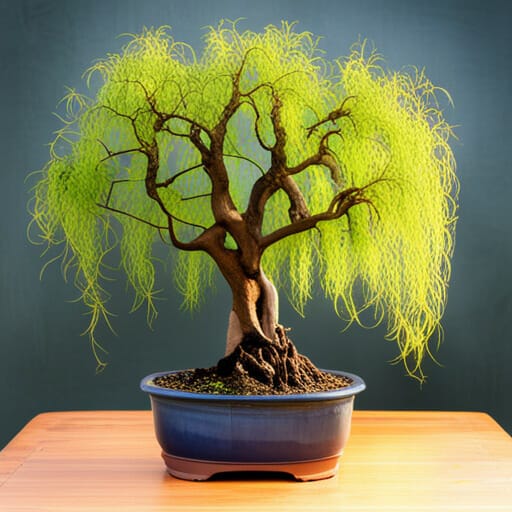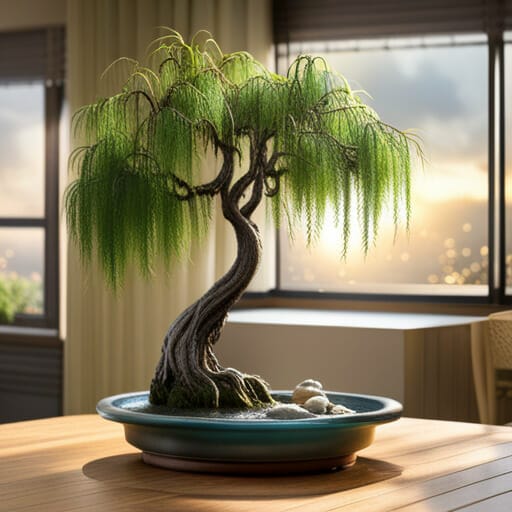Weeping willow bonsai, scientifically known as Salix babylonica, are beautiful and captivating trees with their downward-weeping branches. These bonsai, originating from Northern China, are commonly found near water sources like river banks and lakes across Europe.
Care for these bonsai involves maintaining a damp soil mix and ensuring a dish of water is always present under the pot. They can tolerate full sun and are hardy in the UK, enduring temperatures as low as -10°C/14°F. Monthly feeding with all-purpose fertilizer during the growing season is recommended, and pruning stimulates new bud growth. Due to their aggressive roots, repotting should be done frequently. Wiring can be utilized to achieve the desired weeping foliage, especially in younger trees. These bonsai are susceptible to pests like aphids and honey fungus.
Propagation through cuttings is straightforward, as they contain a natural rooting hormone. With a lifespan of approximately 50 years, weeping willow bonsai are an excellent choice for bonsai enthusiasts with some experience.
In this article, we will provide tips for the care and propagation of weeping willow bonsai, ensuring their health and longevity.
Contents
- 1 Quick Points
- 2 What is it?
- 3 Growing Conditions
- 4 Maintenance Tips
- 5 Frequently Asked Questions
- 5.1 Are there any specific pests or diseases that commonly affect Weeping Willow bonsai?
- 5.2 How long does it typically take for a Weeping Willow bonsai to grow to its full size?
- 5.3 Can Weeping Willow bonsai be grown indoors as well, or do they require outdoor conditions?
- 5.4 What is the best time of year to prune a Weeping Willow bonsai?
- 5.5 Can a Weeping Willow bonsai be trained to have a different shape, or is the weeping foliage the only option?
Quick Points
- Weeping willow bonsai, scientifically known as Salix babylonica, originate from Northern China and can be found near water sources across Europe.
- Care for weeping willow bonsai involves maintaining a damp soil mix and a dish of water under the pot, as they prefer high moisture content in the soil.
- Weeping willow bonsai can tolerate full sun and are hardy in the UK, withstanding temperatures as low as -10°C/14°F.
– Regular maintenance, including pruning to stimulate new bud growth, wiring for desired weeping foliage, and monthly feeding with all-purpose fertilizer during the growing season, is crucial for the health and growth of weeping willow bonsai.
What is it?

The weeping willow bonsai, scientifically known as Salix babylonica, is a medium-sized tree with downward-weeping branches that originates from Northern China and can be found across Europe, often near water sources such as river banks and lakes.
This bonsai variety is characterized by its graceful, pendulous foliage and elegant appearance. It requires specific care to thrive, including a damp soil mix of perlite, molar clay, and compost, as well as the presence of a dish of water under the pot at all times. Weeping willow bonsai can tolerate full sun and are hardy in the UK, able to withstand temperatures down to -10°C/14°F.
They should be fed monthly during the growing season with all-purpose fertilizer and benefit from regular pruning to stimulate new bud growth. It is worth noting that weeping willow bonsai have aggressive roots, requiring frequent repotting, and can be wired to achieve the desired weeping foliage.
This variety is not recommended for beginners due to its rapid growth and potential for die back, but it is a good choice for propagation from cuttings as they contain a natural rooting hormone.
Growing Conditions

Optimal growing conditions for the weeping willow bonsai include a soil mix with high moisture content, full sun exposure, and regular feeding with all-purpose fertilizer during the growing season. The weeping willow bonsai thrives in damp soil, therefore a mix of perlite, molar clay, and compost is recommended. This soil mixture ensures that the bonsai receives the necessary moisture it requires for healthy growth. Additionally, the weeping willow bonsai prefers full sun exposure, as it can tolerate direct sunlight. This allows the tree to photosynthesize effectively and promote overall vigor. Furthermore, regular feeding with all-purpose fertilizer once a month during the growing season provides the necessary nutrients for the bonsai’s growth and development. These optimal growing conditions contribute to the overall health and aesthetic appeal of the weeping willow bonsai.
| Growing Conditions | |
|---|---|
| Soil Mix | High moisture content, composed of perlite, molar clay, and compost |
| Sun Exposure | Full sun |
| Fertilizer | All-purpose, applied once a month during the growing season |
Maintenance Tips

Regular maintenance is essential for the proper growth and health of the weeping willow bonsai. To maintain its overall appearance and promote new bud growth, pruning is necessary. By selectively removing branches, the tree can be shaped and maintained at a desired size. It is important to prune during the dormant season to minimize stress on the tree.
Additionally, regular watering is crucial to keep the soil consistently damp, as the weeping willow bonsai prefers a moist environment. However, it is important to avoid overwatering, as this can lead to root rot.
Fertilizing the bonsai once a month during the growing season with an all-purpose fertilizer will provide the necessary nutrients for healthy growth.
Moreover, repotting should be done every one to two years to prevent root congestion.
By following these maintenance tips, the weeping willow bonsai can thrive and bring joy to its caretaker.
Frequently Asked Questions
Are there any specific pests or diseases that commonly affect Weeping Willow bonsai?
Common pests that can affect weeping willow bonsai include aphids and honey fungus. These pests can cause damage to the tree if not properly managed. Regular monitoring and appropriate pest control measures are recommended to maintain the health of the bonsai.
How long does it typically take for a Weeping Willow bonsai to grow to its full size?
The growth rate of a weeping willow bonsai can vary depending on various factors such as environmental conditions and care. However, it typically takes several years for a weeping willow bonsai to reach its full size.
Can Weeping Willow bonsai be grown indoors as well, or do they require outdoor conditions?
Weeping willow bonsai thrive outdoors, as they require full sun and a damp soil mix. Growing them indoors may be challenging due to their rapid growth and aggressive roots.
What is the best time of year to prune a Weeping Willow bonsai?
The best time to prune a weeping willow bonsai is during the dormant season, which is typically in late winter or early spring. Pruning at this time promotes new bud growth and allows the tree to recover before the growing season begins.
Can a Weeping Willow bonsai be trained to have a different shape, or is the weeping foliage the only option?
A weeping willow bonsai can be trained to have a different shape through careful pruning, wiring, and shaping techniques. While the weeping foliage is a characteristic feature, it is not the only option for the bonsai’s overall shape.




